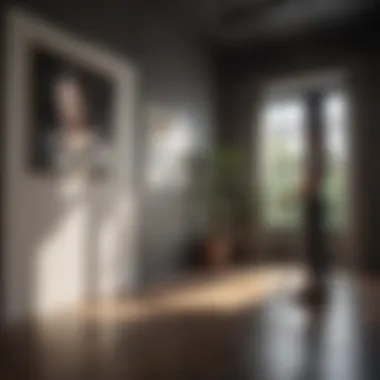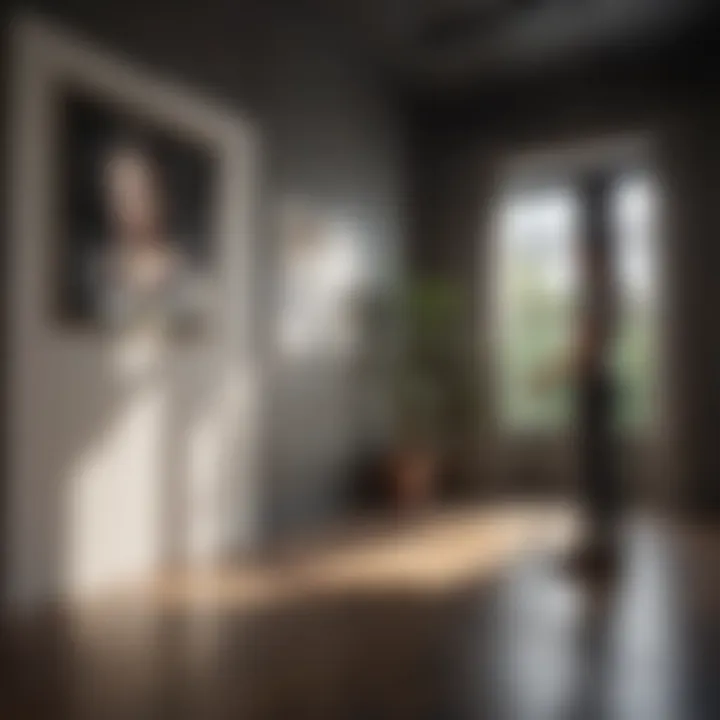Optimal Heights for Picture Hanging in Any Room


Intro
Hanging pictures is a fundamental aspect of interior design that influences how a space is perceived. The height at which art is displayed can significantly affect viewer engagement and the overall aesthetic of a room. Many people underestimate the impact of picture placement, often leading to mistakes that detract from their intended effect. This article seeks to illuminate the factors influencing the proper height for hanging pictures, offering practical guidelines for achieving optimal displays. Understanding elements like eye level, room purpose, and viewer interaction is key to creating a harmonious and visually appealing environment.
Home Design Inspiration
When approaching home decor, one can draw inspiration from various architectural styles and innovative trends. Each style has its own character, impacting how art can be appreciated when integrated into the overall design.
Architectural Styles
- Modernist Design: In a minimalist space, artworks should be hung at eye level to create a sense of balance. It allows the piece to engage the viewer immediately, enhancing the open spaces typical of modernist architecture.
- Traditional Decor: In more classic environments, artworks are often hung higher, sometimes around 60 inches from the floor to the center of the piece. This method complements the ornate styles and heavy furniture often found in traditional settings.
- Industrial Chic: Here, exposed brick walls or metal accents often form a backdrop for bold art. Hanging work lower can contrast nicely with high ceilings, creating a sense of intimacy within an expansive area.
Innovative Decor Trends
Current trends advocate for a more personalized touch in picture hanging, moving away from rigid constraints. Some notable trends include:
- Gallery Walls: A collage of frames at various heights can add visual intrigue. The collective eye level can differ based on the center point of the arrangement.
- Mixing Media: Incorporating different materials (wood, metal, fabric) for frames requires consideration of height; elements should complement one another visually.
"Art does not belong to the wall but rather to the viewer's eye. Respecting individual preference shape the energy of a room."
Epilogue
Understanding the dynamics of picture hanging is an art in itself. The height you choose reflects not only your style but also the functionality of the space. By considering the various factors discussed, you can create a sophisticated gallery that transforms your environment into a more engaging and aesthetically pleasing place. Achieving the right picture height is a blend of personal taste and design principles.
Prelude to Hanging Pictures
Hanging pictures is a fundamental aspect of interior design that significantly influences a room's aesthetic appeal. The height at which art is displayed can affect not only the visual harmony of the space but also the viewer's engagement with the artwork. When planning how to hang pictures, one should consider various elements such as eye level, room function, and the dynamics between pieces of art. Proper placement contributes to an inviting environment, encouraging people to connect with displays in a meaningful way.
Each decision in this process holds importance. A well-placed picture draws the eye and can enhance a room's overall design. Conversely, misjudged height can result in art that feels out of place or uninviting. Therefore, understanding the nuances of picture placement is crucial for cultivating an aesthetically pleasing environment that resonates with its viewers.
Importance of Proper Picture Placement
The placement of pictures carries both functional and artistic significance. A picture positioned at an appropriate height engages viewers and invites interaction. Art can tell stories, evoke emotions, and create focal points within diverse spaces. When placed correctly, pictures frame narratives, enhance themes, and complement the room's decor, ultimately contributing to a cohesive look.
Moreover, proper placement becomes critical in public settings like galleries or businesses, where artworks must be accessible and eye-catching. Those who take time to understand placement will find their spaces transformed through well-displayed art. The right height assures that the viewer's line of sight aligns comfortably with the artwork, allowing them to appreciate it fully.
Overview of Factors Influencing Height
Several factors play a vital role in determining the appropriate height for hanging pictures.
- Eye Level: The eye level of the average viewer is often considered the standard height for picture placement. Understanding this baseline helps create a balanced visual appeal.
- Room Purpose: The function of the room will influence how art is best displayed. A dining room may benefit from lower placements that promote intimacy, while a hallway may require a higher position to accommodate foot traffic.
- Furniture Placement: The height of surrounding furniture also needs consideration. Low sofas or high bookshelves can change the optimal height for art. Ensuring art is visible in context adds to the overall design.
- Type of Art: Different styles of art might require distinct hanging heights. Large pieces may benefit from a high hang to create impact, while smaller artworks could feel lost if placed too high.
By integrating these factors, one establishes guidelines that lead to thoughtful and strategic picture placement, enhancing the interior's visual appeal.
Understanding Eye Level
Understanding eye level is crucial when it comes to hanging pictures. Eye level influences how viewers perceive art and can significantly affect the overall ambiance of a space. Proper placement, aligned with eye level, encourages engagement with the artwork, allowing it to become a focal point in the room.


Defining Eye Level in Design
Eye level typically refers to the height at which an average person's eyes align when standing or sitting. This height can vary, but it is commonly around 57 to 60 inches from the floor for artwork in a gallery setting. Measuring at this level allows for a natural viewing experience. Understanding this concept helps in designing a cohesive display that feels intentional and expressive.
It’s worth noting that eye level is not a fixed measure. Factors such as the primary use of a room and the demographics of the primary users should be considered. For example, in a children's room, a lower hanging height may be more appropriate to engage young viewers directly. Conversely, in spaces primarily occupied by adults, adopting a standard eye level will likely create a more inviting atmosphere.
Where to Measure Eye Level
To determine the right height for hanging pictures, start by selecting the area where the artwork will reside. You should measure the height of the wall and mark the central point. From this midpoint, measure 57 to 60 inches upwards, marking the area where the center of the artwork should align. This approach ensures that the art draws attention without overwhelming or being overlooked.
A quick tip is to take note of the height of furniture pieces around the planned artwork. For instance, if the picture will hang above a sofa, higher placements might be necessary to allow clear visibility.
When it comes to measuring, a simple measuring tape suffices. Use a pencil to lightly mark positions on the wall. This allows for adjustments and is less permanent than using nails right away. You can also use a level to ensure that your marks are even, which is essential for a polished final look.
"Understanding eye level is essential for creating a harmonious display that resonates with viewers while enhancing the overall design of a space."
Factors to Consider
When contemplating the right height for hanging pictures, several factors come into play. Understanding these factors can greatly enhance the visual appeal and functionality of your space. Each element interacts with others, and neglecting one can lead to an unsatisfactory arrangement. Here are three significant factors to consider:
Room Purpose
The purpose of the room plays a crucial role in determining the appropriate height for artwork. Consider whether it is a living area, bedroom, or office space. In spaces where relaxation takes place, such as living rooms, it's often more enjoyable to hang pictures at eye level. This encourages interaction and engagement among viewers.
On the other hand, in more functional areas like offices, you might opt for a slightly higher position to keep distractions to a minimum. Here, the art complements the environment without overwhelming it. Furthermore, children's rooms may benefit from lower placements, which allow kids to appreciate the artwork.
Furniture Placement
The placement of furniture can dramatically influence how art is perceived in a room. For example, if a sofa or table is present under a picture, the height should be adjusted so that the artwork does not compete with these pieces. A general guideline is to hang art about 6 to 12 inches above furniture.
Additionally, consider the flow of movement in the space. If an area tends to be crowded, higher placements could ensure that the artwork remains visible without obstructing pathways.
Type of Art
The nature of the artwork itself can also affect placement strategy. Large pieces often require more height to ensure they harmonize with the overall room aesthetics. When dealing with smaller art, you might consider grouping them closely together or placing them at eye level for better visual impact.
Furthermore, thematic art, such as landscapes or portraits, may draw viewers in differently, necessitating adjustments to placement. In rooms where storytelling through art is critical, consider how the type of art interacts with viewer's expectations and emotions.
Remember: The interplay between the room purpose, furniture, and art types is key to creating an inviting atmosphere.
Common Guidelines for Hanging Pictures
Establishing common guidelines for hanging pictures is essential in achieving a well-organized and aesthetically pleasing display. These guidelines offer a framework that balances visual harmony and practical considerations when placing artwork. Familiarity with these principles allows homeowners and design enthusiasts to enhance their spaces effectively without falling into common pitfalls. An appropriate arrangement can elevate the aesthetic quality of a room and create a cohesive environment for both residents and visitors.
General Rule of Thumb
A widely accepted guideline in interior design is to hang artwork at eye level. Generally, this height is considered to be around 57 to 60 inches from the floor to the center of the artwork. This rule serves as a starting point for various installations. However, it’s crucial to note that personal preferences and artistic intentions should also guide decisions. For example, if a piece is particularly large or features intricate details, adjusting its height could improve the overall impact.


Variations Based on Wall Space
While the eye level rule provides a basic guideline, there are significant variations depending on wall space. In smaller rooms, hanging pictures higher can create a sense of openness and draw the eyes upward, making the space feel larger. Conversely, in expansive areas such as grand hallways, artworks should be sized appropriately and spaced further apart. When multiple pieces are arranged, maintaining even spacing helps unify the display and prevents overcrowding. Thus, recognizing the unique characteristics of every wall is vital for achieving an appealing arrangement.
Aligning with Other Objects
Aligning pictures with furniture and other room elements creates visual coherence. For instance, hanging artwork above a sofa or console table should match the width of the furniture piece to maintain balance. This alignment fosters a seamless transition from one element to another and enhances the overall composition of the space. Additionally, if artwork is grouped with other decorative items, ensuring consistent spacing and alignment provides a more intentional and curated look.
By observing these guidelines, individuals will not only maximize the impact of their art display but also contribute to a thoughtful and well-structured interior design. With these strategies in mind, one can confidently approach the task of hanging pictures.
Visual Grouping Techniques
Visual grouping techniques are essential in achieving a harmonious display of photographs and art. This aspect plays a crucial role in the overall aesthetics and functionality of any space. Effective grouping can transform a single piece of art into a cohesive collection that draws the eye of the observer.
Creating Cohesion in Display
To create a cohesive display, consider the style, color palette, and theme of the artworks. Grouping pieces with similar colors or themes can enhance the overall narrative of the display. Ensure there is a common thread, whether it's the subject matter or artistic style. This method generates a unified look, making the artwork feel intentional rather than scattered.
Here are a few tips to keep in mind when creating cohesion:
- Size and Scale: Use varying sizes of frames and artwork to create interest. Display larger pieces to serve as focal points, while smaller works can complement them by filling in the gaps.
- Spacing: Maintain consistent spacing between the pieces. Usually, 2 to 5 inches between frames is a good guideline. This provides enough room for each piece to breathe without creating clutter.
- Alignment: Aligning the top or bottom edges of frames can lead to a more professional appearance. You can also opt for a more relaxed look by staggering the heights of the artwork.
Cohesiveness in art display not only enhances the visual appeal but also helps communicate a story or emotion effectively.
Using Frames and Borders
Frames and borders are not just protective layers but also significant design elements that contribute towards the visual impact of a display. Selecting the right frames can make a difference in elevating the artwork's presentation.
- Frame Styles: Choosing a consistent frame style adds a layer of cohesion to the display. You might prefer sleek, modern frames for contemporary art or ornate wooden frames for classic pieces. The style should resonate with the theme of the art and room.
- Color Choices: Frames can either complement or contrast with the art. Neutral colors, such as black or white, often work well, whereas a bold color can create interest and draw attention.
- Borders: In addition to frames, consider the use of matting. A well-chosen mat can enhance the aesthetic quality of the artwork. It provides separation from the wall and prevents crowding of the visual space.
The right combination of frame styles and borders can unify a diverse assortment of pictures and help convey a consistent message within a room.
Avoiding Common Mistakes
Hanging pictures is not just about finding a wall and putting up art; it involves a nuanced understanding of certain factors that can significantly impact the overall visual appeal of your space. Avoiding common mistakes during this process enhances the effectiveness of art display, making your environment not only aesthetically pleasing but also harmonious. The wrong choice in height or placement can disrupt the flow of a room and detract from the art pieces themselves. Thus, adhering to certain guidelines and being aware of errors can save time and improve the overall design of your interiors.
Hanging Too High or Low
One of the most frequent errors homeowners make is hanging pictures at an inappropriate height. When art is hung too high, it can make the ceiling feel lower and lead to a visual disconnect, taking the viewer's attention away from the art itself. Conversely, hanging art too low may crowd the room and could even be obstructed by furniture or foot traffic.
To ensure that art pieces complement the room, aim for the center of the artwork to be at eye level for the average viewer, typically around 57 to 60 inches from the floor. This height facilitates comfortable viewing without straining the neck or losing the context of the room. However, factors such as ceiling height and furniture proximity must also be considered.
"Consider adjusting the height based on the room's purpose and viewer engagement. It is not merely a formula; it varies with each space."
Ignoring Room Dynamics
Another significant mistake is overlooking the dynamics within a room. Each space has its own character, influenced by factors like natural light, room function, and furniture layout. Ignoring these dynamics can lead to poor placement of art. For instance, in a livingroom where people gather, art should be positioned to encourage dialogue and interaction. In comparison, a dining area may require pieces that enhance an inviting atmosphere.


Taking the time to assess room dynamics involves considering the relationship between the art and the surrounding space. Key elements include:
- Light: Natural light can interact with colors and textures, so think about when the room has light the most.
- Action Zones: Where people gather or pass through should inform the best height and placement for art.
- Style Consistency: Each piece should relate to the overall decor style, such as modern, traditional, or eclectic.
Ultimately, understanding how these dynamics function together leads to a more cohesive and intentional design, further enhancing the beauty of a space.
Tools and Techniques for Accurate Hanging
Hanging pictures might seem straightforward. However, improper tools and techniques can lead to frustration and poor outcomes. To make the process seamless, it's essential to understand which tools to use and the methods that work best for different scenarios. The right tools not only aid in precision but also enhance the visual appeal of the artwork.
Using appropriate tools ensures that the art is securely mounted and displayed at an optimal height. Tools play a critical role in achieving those ideal viewing angles while preserving the integrity of walls and frames.
Moreover, knowing various hanging techniques can help you adapt to unique situations, such as walls with irregular surfaces or art pieces of different weights. This knowledge empowers individuals to express creativity effectively.
Essential Tools
A few key tools are necessary for successfully hanging pictures. Here’s a closer look at some essentials:
- Measuring Tape: Accurate measurements are critical. This tool allows you to determine eye level and spacing between frames easily.
- Level: Ensuring your pictures are straight matters greatly in presentation. A level helps avoid any tilt.
- Pencil: Marking the spots where you plan to drill or nail will save you from misalignment.
- Hammer and Nails: Basic yet essential, these tools secure the frame to the wall. Make sure to use the correct type of nails for your wall material.
- Picture Hooks: For added support, particularly with heavier frames, a picture hook can provide stability beyond standard nails.
- Stud Finder: If you are hanging particularly heavy pictures, a stud finder will help locate wall studs for more secure hanging.
Using these tools improves the overall outcome of hanging art, making the entire process less stressful.
Hanging Methods and Considerations
Different methods for hanging pictures can significantly affect both aesthetics and functionality. Consider the following:
- Two-Hook Method: This involves using two hooks to distribute weight evenly. This is ideal for larger frames.
- Command Strips: For lightweight frames, adhesive strips offer an easy solution with no wall damage.
- Gallery Wall: Hanging multiple pieces together creates a visual narrative. Layout beforehand on the floor to visualize how they will look on the wall.
- Laddered Arrangement: This technique adds interest by placing pictures in a staggered formation, drawing the eye naturally across the space.
"When you take the time to select tools and methods suited for your specific needs, the quality of the outcome is markedly improved."
Each method comes with its benefits and considerations. The choice largely depends on the type of art, wall material, and desired visual effect. Experimenting with different techniques can lead to an impressive display, creating an enchanting ambiance that resonates with the viewer.
Finale
In any exploration of interior design, the significance of hanging pictures at the right height cannot be overstated. This article delves into the ways proper picture placement contributes to the overall coherence and aesthetic appeal of a space. By understanding how elements like eye level and room purpose intertwine, individuals can curate an environment that is not only visually pleasing but also functional.
The benefits derived from appropriate picture hanging extend beyond mere decoration. They foster a sense of harmony and flow within a room. When art is placed thoughtfully, it invites interaction, enhances spatial dynamics, and can even influence emotions. Each room's unique characteristics demand consideration of the viewer's perspective and context, ensuring that the arrangement resonates well with those who inhabit the space.
Moreover, this discussion highlights practical methods and techniques that mitigate common mistakes in placement. It empowers homeowners and design enthusiasts to take control of their environments. With increased awareness of how art engages viewers, the correct hanging height transforms ordinary walls into striking focal points.
"The right height for hanging pictures can create a transformative impact, merging aesthetics with user engagement."
As one reflects on the guidelines and factors outlined, it becomes evident that achieving balance in picture placement nurtures a deeper appreciation for art and design in everyday life.
Recap of Key Points
- Understanding eye level is fundamental to ensuring art resonates with viewers.
- Considerations of room purpose and how furniture placement affects visuals are crucial.
- Common hanging guidelines serve as a baseline, but flexibility is essential to match personal styles.
- Visual grouping techniques can enhance cohesion, creating a unified feel.
- Avoiding common mistakes ensures that intentionality shapes each display, not carelessness.
Encouragement for Personalization
Every space tells a unique story. As such, the height at which pictures are hung should reflect the personality of the inhabitants and the intended atmosphere. There is no one-size-fits-all approach. Let individual preferences guide how art is curated.
Experimenting with different heights and layouts can yield surprising results. Lay out your pictures on the floor, testing various arrangements before committing to the wall. This active involvement allows for innovation, resulting in a space that truly embodies one's style.







